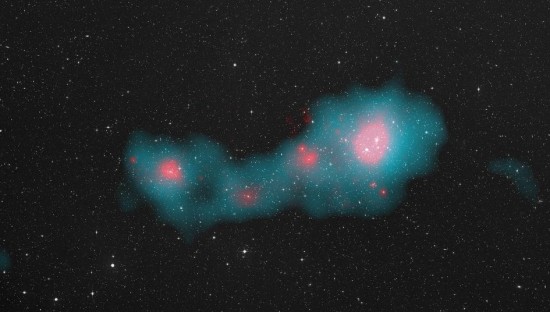
The Shapely Supercluster, said to be one of the most massive objects in the Universe. Credit: ESA & Planck Collaboration/Rosat/Digitised Sky Survey.
Aug 3, 2015
Galaxy clusters are thought to be pulled by a force emanating from “beyond the horizon” of the Universe.
Astronomers believe that the Universe is expanding at an ever accelerating rate. Contemporary theories suggest that galaxies are receding from us because they started out receding from us due to an inflationary event imparted by the Big Bang. Current estimates put the figure at approximately 71 kilometers per second for every 3.3 million light-years. This supposed dilation of space/time is called the Hubble flow, or the Hubble constant.
In the 1960s however, redshift measurements of the galaxies near the Milky Way seemed to show a large-scale motion superposed on the Hubble flow. The Local Group, the Virgo supercluster, the Hydra-Centaurus supercluster, and other galactic superclusters are moving at 600 kilometers per second toward the constellation Centaurus. Scientists describe the motion as “a great river of galaxies” that is flowing into the gravity well of some gigantic gravitational source over 150 million light-years away. The massive structure is known as the Great Attractor.
According to a recent report, redshift measurements of galaxies in the Local Group show them flying toward the center of the Virgo cluster at nearly two million kilometers per hour. The Virgo cluster is 50 million light years from Earth and contains two giant elliptical galaxies, M84 and M86, but whatever is tugging on that incredible mass remains invisible.
In order to explain all these combined redshifts, a group of objects called the Great Wall (or the Centaurus Wall) in which the Great Attractor is embedded was theorized to be the motivating factor. However, the Great Wall does not possess enough mass density to influence structures like superclusters. These various surveys (along with other data) led to the theory of dark matter.
Another force, only this time orders of magnitude more powerful than the Great Wall and its Great Attractor scion, is thought to exist so far away from Earth that it is outside the range of the most powerful telescopes. In keeping with the terminology that has become familiar to astronomers the unseen power Is called, “dark flow.”
Astronomer Alexander Kashlinsky once wrote: “The clusters show a small but measurable velocity that is independent of the universe’s expansion and does not change as distances increase. We never expected to find anything like this.”
How many times are reports from respected scientists, operating complex devices designed to test their theories, going to begin or end with the words, “we never expected this?” Notwithstanding the problems associated with redshift, previous Picture of the Day articles about WMAP, galaxy clusters, and gravity-only cosmology have elucidated a force extant in the universe exerting an attractive power many orders of magnitude greater than gravity: electricity. Each “puzzling” discovery by research scientists reinforces the tenets of plasma cosmology and serves to differentiate it from the imprecise predictions of consensus models.
Clusters of galaxies are pinches in a supergalactic Birkeland current. The usual morphology of a Birkeland current is a double helix, or a hierarchy of double helices. With greater resolution, each filament of a current is, at a smaller scale, a tube of filaments which, in pairs, tend to spiral around a common axis.
Forces exerted by electrified plasma contained in the twisting filaments of Birkeland currents dominate the universe. They circulate in a cosmic circuit that flows into our field of view and then out into the void with long-range attraction between them. Therefore, the most probable “Great Attractors” are those filaments of electrified plasma with billions-of-trillion-times more intense fields of influence than gravity.
No doubt the Universe is larger than what we can observe at this moment because more sensitive tools have continued to reveal greater depths. Out of those depths rise electrical energies of tremendous power. It is there we should look for our explanations and not to centuries-old hypotheses conceived in a time when none of today’s observations were possible.
Stephen Smith












